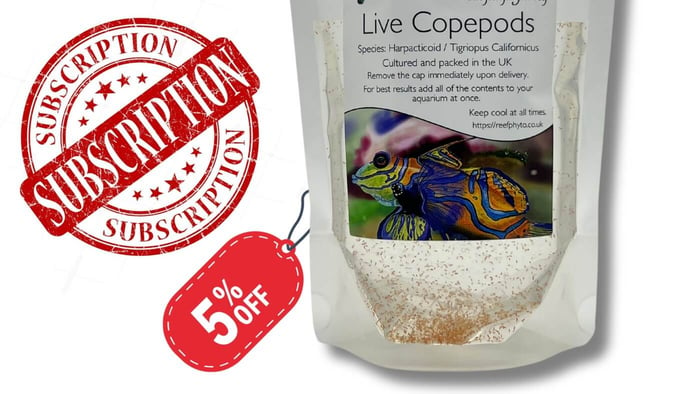Reef aquarium enthusiasts understand the importance of maintaining a thriving and balanced ecosystem within their tanks. An essential component of this equilibrium is providing your corals and marine life with proper nutrition. Live copepods, tiny crustaceans, are crucial in sustaining a healthy reef tank. In this blog post, we'll delve into the world of copepods, their significance, and the ideal frequency for adding them to your aquarium.
The Role of Copepods in a Reef Tank:
Copepods are small, planktonic organisms found in both marine and freshwater ecosystems. In reef tanks they serve a multitude of essential functions:
1. **Natural Food Source:** Copepods are a natural and nutritious food source for marine life, including corals, fish, and invertebrates. Their small size makes them easily accessible for most tank inhabitants.
2. **Biodiversity:** Introducing copepods can enhance the biodiversity of your tank, creating a more dynamic and self-sustaining ecosystem.
3. **Nutrient Recycling:** Copepods help recycle nutrients in your aquarium, contributing to its overall balance and health.
4. **Symbiotic Relationships:** Some copepod species establish symbiotic relationships with corals and other invertebrates, benefiting the overall health of the reef.
How Many Copepods Should You Add?
Our customers ask, "How many copepods do I need for my tank?" The answer depends on the number and type of tank inhabitants, the sump and refugium size, and other factors.
If you have voracious copepod eaters like a Mandarin Dragonet (Goby) or a Leopard Wrasse, it would be a good idea to add more pods monthly as they can quickly become depleted and to ensure the population remains healthy.
1. Nano Reef Tank: These are typically small aquariums with 10 to 30 gallons capacity. We recommend adding 100 - 250 ml of copepods monthly to maintain a current population.
2. Standard Reef Tank: A standard reef tank usually ranges from 50 to 150 gallons in size. We recommend adding 250 to 500 ml of copepods monthly to maintain a current population.
3. Large Reef Tank: Reef tanks larger than 150 gallons. We recommend adding 1000 ml + of copepods monthly to maintain a current population.
Marine Life and Feeding Habits:
Evaluate the number and type of marine life in your tank. Fish primarily feeding on copepods, such as mandarin fish, may require more frequent additions.
Corals and other filter-feeding invertebrates can also benefit from copepod supplementation, as they capture plankton from the water column.
Observe Your Tank:
Regularly monitor the behaviour and health of your tank inhabitants. If you notice signs of hunger or stress in your fish or corals, consider increasing the frequency of copepod additions.
Reefphyto Subscription Services:
Consider utilising a subscription service like Reefphyto, which offers live copepods and other essential aquarium live foods with a 5% discount. These services can help ensure a consistent and convenient supply of copepods for your reef tank.
Conclusion:
Adding live copepods to your reef aquarium is beneficial for maintaining a thriving and balanced ecosystem. The appropriate quantity of copepods to add depends on factors like tank size, the needs of your marine life, and observations of your aquarium. Balance is key, and regularly monitoring your tank's health is crucial.
By providing your marine life with a reliable source of copepods, you can enhance the vitality of your reef tank and enjoy a more vibrant and sustainable underwater world. Utilising subscription services like Reefphyto ensures you can conveniently and consistently supply your tank with these vital organisms while saving money with the 5% discount.

